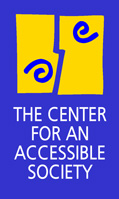
DISABILITY
ISSUES
INFORMATION
FOR
JOURNALISTS
TOPICS
ABOUT
THE CENTER
To see how the Center for An Accessible Society's home page would look if you were using a text-only web browser such as Lynx, look at it in Lynx-view.
"It's bold, it's bright, it's digital Braille," said Tony Wessling, founder and
Chief Creative Officer of Wessling Creative. "We're very proud to have built a
beautiful site for the LightHouse that can be enjoyed by people using screen reader
software, refreshable Braille displays, screen magnification programs or your
ordinary web browser."
Making Web sites accessible
is just common sense. One in five Americans has some disability; as the country ages, that percentage is expected to increase. A Web site that's navigable by an assistive technology such as a screen reader is also accessible by phones and palmtops, not to mention by old, slow computers. Read reporter Judy Heim's overview of online accessibility in the September, 2000 PC World online.
It's part of Section 508 of the 1973 Rehabilitation Act which was revised in
1998. The section spells out, for the first time, standards for developing
accessible web pages.
Considering the number of people who use the Internet who need a way to listen to text and navigate with voice, web
accessibility makes sense. An article in the May 21 Federal Computer Week gives a good overview of the issue.
The National Park Service has a number of links to valuable accessibility
resources including simplified version of the guidelines at
http://www.nps.gov/access/target.htm
If you're a web developer, JAWS For Windows has a trial version you can
download to test how your site sounds to text-to-voice screen readers, at
http://www.hj.com/JAWS/JAWS.html
And Bobby, a free service provided by the Center for Applied Special Technology, can help web page authors identify and repair significant barriers to
access by individuals with disabilities.
Does the Americans with Disabilities Act apply to the Internet?
Several laws govern accessibility of websites.
What are the implications of requiring the Internet to be accessible to everyone?
While opponents of access claim it is costly to provide access, in fact the opposite is true: It is the added-on graphics and other showy displays of sound and animation that are costly -- both to produce and to maintain.
Basic access is built into the architecture of the World Wide Web and has been since the infancy of the internet, as Judy Brewer of the World Wide Web consortium can explain.
But even sites that today operate with high-end graphics and sound displays can easily be made accessible.
Accessible sites have many advantages:
What does the law mean by "accessible'?
Making multimedia websites accessible
EXPERTS IN web access:
The Georgia Institute of Technology's Center for Assistive Technology & Environmental Access formed the
Information Technology Technical Assistance & Training Center
to promote the development of accessible electronic & information technology. Reach them at 1-866-948-8282 (Voice/TTY) or by email at webmaster@ittatc.org.
Judy Brewer
Brewer's group develops web guidelines, conducts education and outreach on
Web-accessibility solutions.
Kate Vanderheiden
Pam Gregory
Learn how Georgia Tech's Center for Rehabilitation Technology's assistivetech.net site was made accessible at http://www.assistivetech.net/about/accessibility.cfm
Judith M. Dixon, Ph.D., Consumer Relations Officer for the National Library Service for the Blind
and Physically Handicapped has written "Levelling The Road Ahead," a set of "Guidelines For The Creation Of WWW Pages Accessible To Blind And Visually Handicapped Users" -- online at http://www.rit.edu/~easi/itd/itdv02n4/article6.html
A rather comprehensive set of links for accessible website authoring can be found at http://www.makoa.org/web-desi.htm
All of Camera Obscura's index of academic and scholarly resources are either easily navigatable with speech or have been extensively re-indexed so that the information they contain is easily and immediately accessible via speech-synthesis and/or text-based access. This document also contains speech-friendly submission forms for many standard reference works, as well as telephone and address directories and resources which are easily navigated using speech-synthesis and a text-based browser.
"Designing a More
Usable World for All," from the Trace Center
http://trace.wisc.edu/docs/eitaac_final_rpt/EITAAC_final_report.htm
Web Content Accessibility Guidelines
Fact Sheet for "Web Content Accessibility Guidelines 1.0"
Web Content Accessibility Guidelines
Web Content Accessibility Guideline Checkpoints
Story about new guidelines from The Associated Press.
The Digital Divide and People with Disabilities
Quick tips on making websites accessible from the Web Access Initiative
The website of the San Francisco-based Rose Resnick LightHouse for the Blind and Visually Impaired has been designed with blind viewers in mind.The
redesigned website is both visually attractive and fully accessible. Developed by San Francisco marketing communications firm
Wessling Creative, the new LightHouse website uses vivid colors, ebullient graphics
and colorful photos.
Business Week Online assistive technology columnist John Williams talks with Microsoft CEO Steve Ballmer about the June 21 deadline for website access -- and the business opportunity it is presenting. Read column.
Web access rules take effect June 21.
Starting June 21, electronic and information technology
products and services that federal agencies buy must meet new accessibility
standards. Federal agencies must also follow these standards. This includes
computers and Internet websites.
Director of the World Wide Web Consortium
Web Access Initiative
617-253-5884
Trace Research and Development Center
at the University of Wisconsin/Madison
Disabilities Issues Task Force
Federal Communications Commission
202/418-2498 or 202/418-1169 (TTY)
Email: pgregory@fcc.gov
OTHER ITEMS OF INTEREST:
The following sites contain information that may be of interest. Please bear in mind that the information at these sites is not controlled by the Center for An Accessible society. Links to these sites do not imply that the Center supports either the organizations or the views presented.
One of the best overviews of the issue of web access we've found is the article "Locking Out the Disabled," from PC World magazine's September, 2000 issue. Lots of good links, too.
"Advocates of People With Disabilities Take Online Stores to Task" from the Jan. 1. New York Times
Links